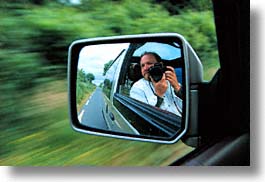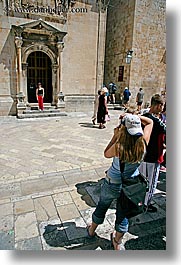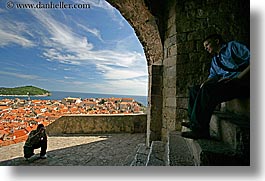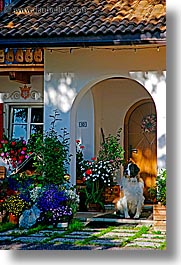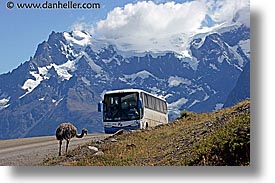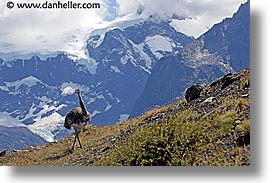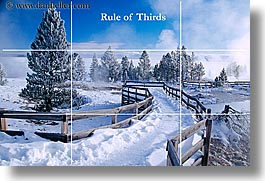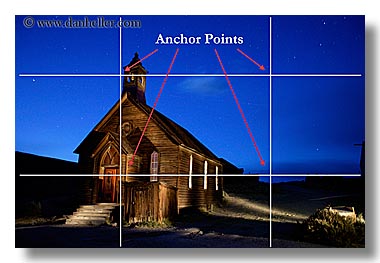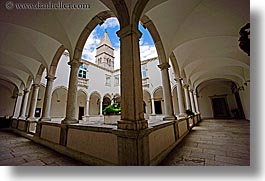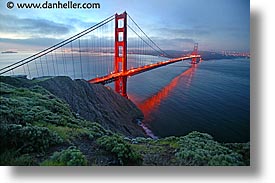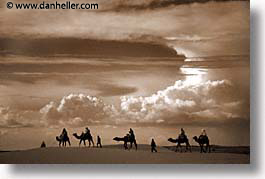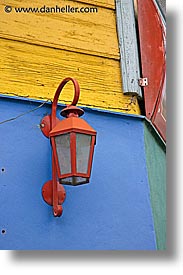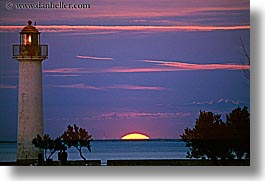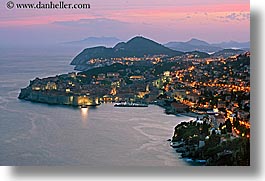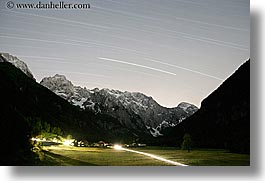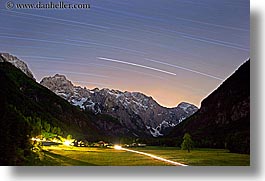|
Click to recommend this page:
| |
 Introduction
Introduction
I admit it. I have a cushy job. I get paid to go on spectacular
vacations that you read about in magazines or see in catalogs, and
I take pictures. What can I say? It's a living. Someone's got to do it.
I know what you're thinking. OK, besides "How can I get a job like
that?" You're thinking, "How hard can it be to just take pictures
on vacation?" You're not alone. In fact, pretty much everyone thinks
the same thing about my job. Early in my travels, one particular
tourist made the following observation: "If you put a great-looking
model on a pristine beach on a beautiful day, and just sit there and
snap a million pictures with great photo equipment, a monkey can
come up with a bunch of great shots." That tourist was me. And the
photographer who was on assignment for that trip replied, "so, why
aren't you taking a million pictures?"
I sat and pondered that for a while. What if I actually did just shoot
indiscriminately as my theory suggested? Would I suddenly find gold
nuggets among them? Normally, I would bring two or three rolls of film
for a two-week vacation, and even then, I may finish all the rolls if
the weather was good. I was determined to test my theory on my next vacation,
a two-week cycling trip to New Zealand. I packed what I thought was
far more film than I ever thought I'd use: 10 rolls. 36-exposures each.
Color. And with my point-n-shoot camera, I exhausted my supply precisely
to the last day. The result? A lot of... well, "bad pictures." (This
is a family book, after all.)
 Composition: The First Step to Better Photography
Composition: The First Step to Better Photography
Clearly, my theory needed rethinking. I was still convinced that there
couldn't be much more to it than what I observed. What is it that
these pros do that I can't do? While it's true that pros tend to have
better equipment, I knew it was more than that. I thought maybe it was
a matter of having better technical skills. But there wasn't really
anything wrong with my exposures. This got me to look more closely at
some of those magazine photos of wonderful places. That's when it struck me:
I noticed composition choices I hadn't seen before. Yes, composition
can truly make or break a photo. What we see everyday in travel brochures
had gone passed me without notice: using a window to frame a landscape,
rather than just taking a wide-angle picture; placing my friends in
the immediate foreground in front of me, rather than far away next to
the ancient cathedral; zooming in close on people, rather than holding
back. Yes, even small, subtle things, like making sure the horizon
(and/or other lines) are level, can have dramatic effects on the
perceived quality of a photograph.
My big epiphany came when I started seeing as the camera does, not as
my eyes do. To see a scene as it will appear as a photo is profoundly
different than the way our eyes see real life. When we walk around,
our brains are wired to see things in real-time, three-dimensional,
live-action movement. We then introduce our emotions into the mix, which
collectively coalesce into "an impression." When we click the camera's
shutter release, we think the camera is capturing the same impression
our brains are seeing at the time, but it doesn't. Reproducing that
same emotional effect requires understanding how we view photographs.
When a tourist takes pictures, he lines up friends or family members like
a football team in front of an ancient cathedral, thinking, "Hey! People
I know! An old church! We're in Spain! We're having fun! Let's take a
picture to capture the moment!" Then when he shows his photos to others,
there's a sort of obligatory "great!", with forced smiles, even though
the pictures are, well, you know, "bad." This is because a bad vacation
photo doesn't capture the same essence of moment that real life provides.
Knowing how the non-vacation brain works is the key. First, viewing
a photograph allows the brain to pick up details that vacation brains
filter out: the telephone wires overhead, or the annoying car on the
left side of the parking lot overlooking Monument Valley. When we see
pictures, we notice all these small artifacts and imperfections that
we often had no idea were even there in the first place. Such details
notwithstanding, the second thing our real-time brains are wired to
do that our photo-viewing brains don't is automatically make certain
adjustments, such as straightening out lines. We always see the horizon
as level, or the side of a building as vertical, even though we may not
be upright ourselves. Our real-time brains also compensate for jittery
motion, or to conceptually put into focus the object of our interest,
and put everything else out of focus (even though our eyes don't really
do that). Our real-time brains also put objects' sizes in perspective
to one another, such as the size of a full moon in a dark sky, or the
proximity of a friend standing next to a statue far away. Our real-time
brains even do color-correction, like the black or blue of nite, or the
amount of red in a sunset. These perceptions are not reality—these are
our brains constructing a reality that makes sense to us. It's easy to
demonstrate this—simply take a snapshot of any of these things and you'll
see the photo doesn't quite look the same as you remember it. Obviously,
the goal is to make photos reconstruct the "impression" that the real-time
brain would have if viewing the same thing.
Perhaps you're thinking at this point, "Hey, I don't want to take great
shots that end up in magazines, and I don't want to ruin the moment
by having to futz with a bunch of thing-a-majigs. I just want to shoot
and go." I understand. But before you get your undies up in a bunch,
you'd be surprised to find that taking a better picture requires no more
time than taking a bad one, nor does it take away from the experience
of whatever you're doing. Once you know what to look for, you can just
as casually and instinctively snap away as you currently do. This is
much the same as how putting on your seatbelt doesn't interfere with
the driving experience once you get in the habit of wearing it; it just
becomes second-nature and you never realize you're doing it.
Though it can certainly be dissected and studied ad nauseum, good
composition is largely intuitive; at some level, you already know
what works and what doesn't—it's more a matter of having it pointed
out to you, so you'll stop overlooking what's always been right in
front of you. To some degree, that's what this book is for: to
present examples that illustrate basic photography guidelines that
contribute to better pictures. When actually attempted in the field,
most people find their pictures improve considerably. By now, I'm sure
you've already paged through this book before reading this first
chapter. (I never read photo books without looking at the photos first.
And usually from the back to the front for some reason.) If you're like
me when I first saw photo books, you were probably thinking, "wow, I'd
like to be there." Great—that's the real-time brain responding to the
photo technique I want you to learn.
When composing a picture, the rule of thirds can promote most any
average photographer to the next level almost instantly. The idea is to
brake down the scene into thirds, both horizontally and vertically. Strong
horizontal objects should line up with (or be "close" to) each of the top
and bottom division lines in the frame. Similarly with strong vertical
objects lining up with the vertical lines.
The four cross-sections where each of the six dividing lines intersect
are potential "anchor points" where you place something, whether it's
simply an intersecting line (such as the horizon), or an actual subject
(such as a doorway, car, light, or person).
The "rule of thirds" is a guideline only, subject to creative judgment;
not every anchor point needs an object, and not every scene has a horizon.
Like learning to drive, "seeing" scenes this way may seem involved when
you first try, but it doesn't take long before it's second nature and you
don't even think about it anymore.
This book does not present a structured curriculum for teaching composition.
I illustrate composition ideas, which are suitable for getting the basics.
This may be suitable for most people, and a large part of the learning
process is simply trying—once you know what to look for, you'll become
better at judging your own photos, or at least other people's pictures. As
long as you learn to critique someone's work, you're on your way to
improving your own. Many websites allow you to upload pictures and have
other people review them. A good search engine will quickly find the
latest and greatest sites for this. (Hint: use "photo critique" as a
search term.) Reading other people's critiques (and the critiques of
those critiques) will quickly get you to see your own photos with a new eye.
For those who are truly eager to learn in a more formalized environment,
local colleges or universities usually offer an introduction to
composition course (whether photography or other art forms). One can
typically grasp all the basics in just a few weeks of hands-on work
with a teacher.
For those who want to guide themselves, what I often suggest is
reproducing pictures you already know. For example, when visiting a new
city, go to any place that sells postcards and look for the top-selling
ones. I was visiting the town of Piran, Slovenia, when I saw this sign
for a monastery. I wanted to reproduce the photo on the sign to use as a
starting point for inspiring new perspectives on the subject. Once I was
there and sought out the location, I had gained had a new perspective
on the building, and was able to produce images reflection my personal
take on it. (See Buildings (Pirano, Slovenia) for examples.)
Sometimes, pros will say, "when I see everyone rush to take the same
picture, I rush the other way!" I feel quite the opposite. There's a
reason people go to a particular spot: because there's a classic photo to
get. Pros want to get "unique" pictures that everyone doesn't have, but
that doesn't require going where others don't go—it requires employing
creativity. Here, I shot the Golden Gate Bridge at 4am, with a very long
exposure to give light to the sky and to enhance the glow of the bridge. I
also used a very wide angle lens to yield a photo you typically don't see.
 The Technical Side
The Technical Side
OK, so it's not all about composition. There are some technical details
involved, especially for complicated shots. And while those who fear
tech-talk are probably more squeamish than they need to be, those who
seek technical details tend to rely on it far too much, thereby failing
to be self-sufficient. Therefore, I'm hoping to reach a happy medium
here. Let me illustrate.
I get the following question in email about many of my photos:
"What were your camera settings when you took that picture? It would
really help me to know that, because I'm a beginner."
This reminds me of the story where Ansel Adams was teaching a photo
workshop in Yosemite National Park, and a student raised his hand.
"What was the aperture setting and shutter speed on that photo of
the moon rising over Half Dome?", Ansel quickly replied, "f64 at 2
seconds." This prompted another student to do the same, "And what
about that photo?" Again, he quickly replied, "f32 at 1 second."
This goes on and on, while the students scribble in their notebooks
the technical information they were told, as if the magician were
giving away his secrets. Finally, someone asked, "How do you remember
all that information?" This time, the answer was more direct, "I
don't. I'm making it up." The pencils stopped, and eyes looked up.
"Beginners always wonder about this information, but it's meaningless.
When you learn how to shoot, it won't even occur to you to ask
such questions, or to remember those settings yourself."
A lot of beginners mistakenly believe that knowing the camera
settings for any given picture will help them learn something, or
give them some guidelines or insights on how the photographic process
works. But, photography is not a paint-by-numbers game, where you
memorize detailed do's and don'ts, and apply them under what appear to be
similar conditions. One cannot possibly learn anything using this method.
In fact, books that provide such information do more harm than good
by perpetuating the illusion of knowledge, thereby delaying the real
learning process.
When I talk about technical matters in this book, I'm not going to
spoon-feed you with "data" that you would regurgitate in the field
to come up with a similar picture. When it comes to learning certain
techniques, like shooting night landscapes, it may be useful to
know that an exposure requires 30 seconds on a tripod, not a single,
hand-held snapshot. Or, that star-trails may require several hours
exposure, not a few minutes. In every case, technical discussions are
intended to be general guidelines about the nature of the photo process,
not information to be stored for later retrieval.
 Setting Expectations
Setting Expectations
Eye-popping photos you see in books, galleries and magazines are rarely
the original images that came out of the camera. Although technology is
getting better, you shouldn't be discouraged if your photos of gorgeous
sunsets just don't come out as spectacularly as the scene appeared in
real life. This isn't your fault, nor that of your camera. It's simply
a matter of how digital sensors capture and store light. That is, it
simply sees light as "data," and cameras are calibrated so that the
"common" pictures come out right. But our eyes are more dynamic than
the traditional daytime picture—they readjust according to various
real-world conditions (including human emotions) that the camera can't
emulate. So, while the camera does a good job at representing real-world
light in those easy, evenly-lit scenes, all cameras begin to falter when
the light gets complex, uneven, or brighter or darker than the typical
middle range of light. Oh, it captures the light OK, but it doesn't
necessarily reproduce it properly in print or even on a computer screen.
This requires human intervention to re-calibrate the picture properly to
restore the light data back into proper alignment. Or, at least, what
the viewer remembers it as being. (Or, ahem, wants it to be.)
To illustrate a dramatic example, the photo on the left illustrates
that color exists in the digital image, but isn't weighted properly
against other colors, yielding a flatter look. Using Photoshop, I
"drew out" the fainter colors to bring the scene back to reality. I did
not introduce new colors that wasn't there—that requires far more skill
that exceeds my abilities (and time, which exceeds my patience). But,
the task of re-balancing colors already in the image is a reasonable,
and more manageable process. Tools such as Photoshop are becoming easier
to use for everyday people, and come with automated tools to do the same
kinds of color-editing you see here.
This book does not get into any discussion of digital editing, but
it is mentioned here for context and to set your expectations of what
you can get from your own photography. Granted, the untrained eye may
never notice such details, and you may well be perfectly happy with
your unedited prints when you get them back from the lab. But, there
will be a time when you try a shot found in this book and say, "I did
exactly what you did, but you got all that shadow detail that I didn't!"
Trust me, it's not you or your camera; it's the post-processing. If you
want to take photography to the next level, learn Photoshop or other
digital editing software. (No, it's not cheating—it's how pictures
are made.)
All that said, I present no photographs here that require technical
facts or skills that aren't at least described sufficiently for you to
accomplish successfully on your own. Some tech details may be necessary
to perform, such as, "reduce the flash power by one stop." Here, you
may feel like it's beyond your reach, but I will also explain (to which
you must understand conceptually) that the flash usually emits more light
than you need for a given type of shot, so you need to reduce it's output
for this picture. If you don't know how to do that, read your flash
(or camera) manual and figure it out.
If you are still intimidated by what appears to be a complicated process,
let me put another thing into perspective: even the best pros never get
the shot right the first time, or at all in some cases. By the time
many photos appear here (or pretty much in any print form), they may
be among the finalists of tens or hundreds of attempts. (In some cases,
over a period of time.) Though some pictures really are just single shots,
it's more often the exception than the rule. One needn't master technical
skills before making good pictures. Over time, you will simply get better
at them, and thus, your overall image yield will improve.
On the other end of the scale, there are certainly those who are
well adept at using their camera, and accordingly, may be worried
that this book may be too simplistic. Again, learn from the Ansel
Adams story above—it's not about the details—it's about the
process. Those who have technical ability are even better candidates
from stepping away from the "tech" and looking at photography from the
big-picture perspective. In that context, this book is well-suited
for the moderately advanced amateur photographer.
As for camera equipment, I assume you have a camera and the basic
knowledge of how it works. While I will include point-n-shoot
cameras in some areas, you are strongly advised to use an SLR camera
and an array of lenses to accomplish the most of the kinds of photos
presented in this book.
 Summary
Summary
In closing, let's return to my own observation about travel photography
years ago and re-evaluate it: given a really great-looking model, a
pristine beach, a sunny day, and great photo equipment, can "anyone"
can come up with great photos? I can honestly say, "yes, if they
simply bother to think conscientiously about what they're doing. That,
and practice a lot." But, before your hire the model, rent the beach,
and buy all that photo gear, spend some time practicing on a beach with
your family (or reasonable facsimile) the next time you're on vacation.
It'll be much more fun.
Click to recommend this page:
|
|
